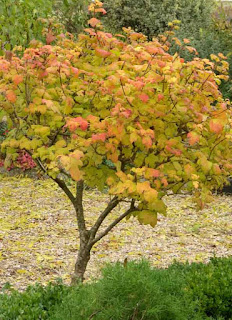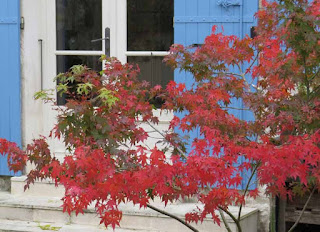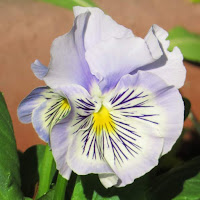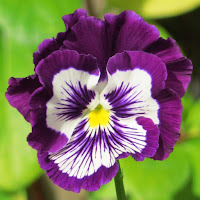"There is a harmony
In Autumn, and a lustre in its sky..."
- Percy Bysshe Shelley
Such a spectacular autumn this year, lasting a full month from mid-October and all the more colourful for there being so many leaves hanging onto the trees, despite a dry spell at the end of summer.
 |
| Viburnum opulus |
Viburnum opulus
Also known as the 'snowball tree' for its white blooms, this was quite late in producing an array of subtle tints after many other trees had already shed their leaves.
The various types of ash growing locally were particularly vivid in their shades of yellow and we've been sweeping up leaves for the past month, filling both leaf bin and compost heap - all contributing to useful humus for future plantings.
 |
| Fallen ash leaves contrasting with the wine-red foliage of hardy plumbago |
Unfortunately we've come to the conclusion that Ceratostigma plumbagnoides, that pretty blue-flowered hardy plumbago which does so well in dry unforgiving soil, is just too invasive for our small garden.
As with many ground cover plants, it served a useful purpose in providing colour when the beds were getting established, but is now leaching both space and nutrients from other desirable specimens which need a more 'careful' upbringing. Yes, we're getting more discriminating these days!
 |
| Physocarpus opulifolius |
Physocarpus opulifolius
This may well be the variety 'Diabolo', which is described as "a stunning, multi-stemmed deciduous shrub", and is not necessarily something we would have heard of - let alone chosen for the garden - until recently when realising we needed more contrast in terms of leaf colour.
Although it's said to prefer acid soil, we've planted it in quite a chalky area and it's still thriving after two years.
Its leaves can appear almost black or bronzy red, depending on the season; you can cut it to the ground in early spring if you want to keep it compact, otherwise it can soon reach three meters in both height and spread.
 |
| Helleborus foetidus 'Miss Jekyll's Scented' |
Helleborus foetidus 'Miss Jekyll's Scented' - now here's a plant with really black foliage!
Again, I hadn't appreciated that fact when I grew it from seed a couple of years ago, as I was more intrigued by the prospect of having a perfume like mahonia wafting through the garden. (So promised my favourite catalogue supplied by those poetic folk at Chiltern Seeds ☺)
As yet the flowers haven't fully opened but the slow evolution of this statuesque specimen has really piqued my interest, especially as it's decided to bloom now when everything else is dying down.
That doesn't apply to the amazing South American salvias which only began blooming about six weeks ago, despite two of them being in almost permanent shade now.
These plants are usually hardy down to -6'C but it's probably a good idea to grow (and protect) some cuttings - if you can actually find any suitable non-flowering shoots!
Determined not to be outdone, at the other end of the garden our Japanese maple is finally putting on its autumn coat, having stayed green for an unusually long time.
Last year it went red in August, seemingly as a result of being stressed in hot weather; but now it's clearly much happier having been sunk - still in its pot - into a raised bed of deep soil.
 |
| Slow-burning Salvia elegans |
These plants are usually hardy down to -6'C but it's probably a good idea to grow (and protect) some cuttings - if you can actually find any suitable non-flowering shoots!
 |
| Still turning - Acer Palmatum |
Last year it went red in August, seemingly as a result of being stressed in hot weather; but now it's clearly much happier having been sunk - still in its pot - into a raised bed of deep soil.
 |
| Camellia sasanqua |
In a corner of the woodland area which still gets some afternoon sunshine, we planted a beautiful autumn-flowering Camellia sasanqua given to us by friends a couple of years ago.
I think it's probably a variety called 'Plantation Pink' and we were a little disappointed to begin with as it was slow to flower, despite being potted in ericaceous compost. But, again, it seems to be proof that some perennials just need to be in the right location in order to thrive.
Although soil here is still a bit on the chalky side, we planted it in humus under the large ash tree, next to other woodland plants like foxgloves, and it has already rewarded us with a succession of blooms.
 |
| The Strawberry Tree - Arbutus unedo - another woodland shrub, grown under the ash canopy |
 |
| Viola x Wittrockiana 'Cats Mix' |
 |
| Viola x Wittrockiana 'Cats Mix' |
Pansies
Like these F1 hybrids grown from seed, certainly help to brighten a shady garden in winter.
Worth ordering from Chiltern Seeds!
 |
| Morning mist over the marais - with reeds and teasels in the foreground |
Two good reasons for getting up early on a cold November morning!


No comments:
Post a Comment